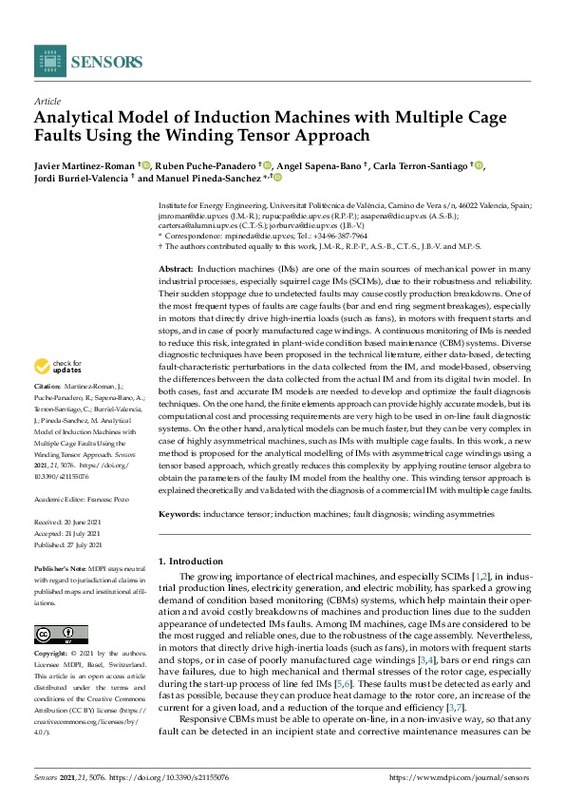JavaScript is disabled for your browser. Some features of this site may not work without it.
Buscar en RiuNet
Listar
Mi cuenta
Estadísticas
Ayuda RiuNet
Admin. UPV
Analytical Model of Induction Machines with Multiple Cage Faults Using the Winding Tensor Approach
Mostrar el registro sencillo del ítem
Ficheros en el ítem
| dc.contributor.author | Martinez-Roman, Javier
|
es_ES |
| dc.contributor.author | Puche-Panadero, Rubén
|
es_ES |
| dc.contributor.author | Sapena-Bano, Angel
|
es_ES |
| dc.contributor.author | Terrón-Santiago, Carla
|
es_ES |
| dc.contributor.author | Burriel-Valencia, Jordi
|
es_ES |
| dc.contributor.author | Pineda-Sanchez, Manuel
|
es_ES |
| dc.date.accessioned | 2022-02-15T19:03:49Z | |
| dc.date.available | 2022-02-15T19:03:49Z | |
| dc.date.issued | 2021-07-27 | es_ES |
| dc.identifier.uri | http://hdl.handle.net/10251/180862 | |
| dc.description.abstract | [EN] Induction machines (IMs) are one of the main sources of mechanical power in many industrial processes, especially squirrel cage IMs (SCIMs), due to their robustness and reliability. Their sudden stoppage due to undetected faults may cause costly production breakdowns. One of the most frequent types of faults are cage faults (bar and end ring segment breakages), especially in motors that directly drive high-inertia loads (such as fans), in motors with frequent starts and stops, and in case of poorly manufactured cage windings. A continuous monitoring of IMs is needed to reduce this risk, integrated in plant-wide condition based maintenance (CBM) systems. Diverse diagnostic techniques have been proposed in the technical literature, either data-based, detecting fault-characteristic perturbations in the data collected from the IM, and model-based, observing the differences between the data collected from the actual IM and from its digital twin model. In both cases, fast and accurate IM models are needed to develop and optimize the fault diagnosis techniques. On the one hand, the finite elements approach can provide highly accurate models, but its computational cost and processing requirements are very high to be used in on-line fault diagnostic systems. On the other hand, analytical models can be much faster, but they can be very complex in case of highly asymmetrical machines, such as IMs with multiple cage faults. In this work, a new method is proposed for the analytical modelling of IMs with asymmetrical cage windings using a tensor based approach, which greatly reduces this complexity by applying routine tensor algebra to obtain the parameters of the faulty IM model from the healthy one. This winding tensor approach is explained theoretically and validated with the diagnosis of a commercial IM with multiple cage faults. | es_ES |
| dc.description.sponsorship | This work was supported by the Spanish "Ministerio de Ciencia, Innovacion y Universidades (MCIU)", the "Agencia Estatal de Investigacion (AEI)" and the "Fondo Europeo de Desarrollo Regional (FEDER)" in the framework of the "Proyectos I+D+i -Retos Investigacion 2018", project reference RTI2018-102175-B-I00 (MCIU/AEI/FEDER, UE) | es_ES |
| dc.language | Inglés | es_ES |
| dc.publisher | MDPI AG | es_ES |
| dc.relation.ispartof | Sensors | es_ES |
| dc.rights | Reconocimiento (by) | es_ES |
| dc.subject | Inductance tensor | es_ES |
| dc.subject | Induction machines | es_ES |
| dc.subject | Fault diagnosis | es_ES |
| dc.subject | Winding asymmetries | es_ES |
| dc.subject.classification | INGENIERIA ELECTRICA | es_ES |
| dc.title | Analytical Model of Induction Machines with Multiple Cage Faults Using the Winding Tensor Approach | es_ES |
| dc.type | Artículo | es_ES |
| dc.identifier.doi | 10.3390/s21155076 | es_ES |
| dc.relation.projectID | info:eu-repo/grantAgreement/AEI/Plan Estatal de Investigación Científica y Técnica y de Innovación 2017-2020/RTI2018-102175-B-I00/ES/DISEÑO DE MODELOS AVANZADOS DE SIMULACION DE AEROGENERADORES PARA EL DESARROLLO Y PUESTA A PUNTO DE SISTEMAS DE DIAGNOSTICO DE AVERIAS "ON-LINE"./ | es_ES |
| dc.rights.accessRights | Abierto | es_ES |
| dc.contributor.affiliation | Universitat Politècnica de València. Departamento de Ingeniería Eléctrica - Departament d'Enginyeria Elèctrica | es_ES |
| dc.description.bibliographicCitation | Martinez-Roman, J.; Puche-Panadero, R.; Sapena-Bano, A.; Terrón-Santiago, C.; Burriel-Valencia, J.; Pineda-Sanchez, M. (2021). Analytical Model of Induction Machines with Multiple Cage Faults Using the Winding Tensor Approach. Sensors. 21(15):1-30. https://doi.org/10.3390/s21155076 | es_ES |
| dc.description.accrualMethod | S | es_ES |
| dc.relation.publisherversion | https://doi.org/10.3390/s21155076 | es_ES |
| dc.description.upvformatpinicio | 1 | es_ES |
| dc.description.upvformatpfin | 30 | es_ES |
| dc.type.version | info:eu-repo/semantics/publishedVersion | es_ES |
| dc.description.volume | 21 | es_ES |
| dc.description.issue | 15 | es_ES |
| dc.identifier.eissn | 1424-8220 | es_ES |
| dc.identifier.pmid | 34372314 | es_ES |
| dc.identifier.pmcid | PMC8347164 | es_ES |
| dc.relation.pasarela | S\445743 | es_ES |
| dc.contributor.funder | AGENCIA ESTATAL DE INVESTIGACION | es_ES |
| dc.contributor.funder | European Regional Development Fund | es_ES |








